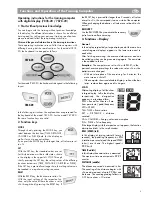
6
Functions and Operation of the Training Computer
GB
CALORIES (2nd right)
In this display the calculated calorie con-
sumption is displayed. The maximum
display is 9999.
The data however only serves as a rough
guideline in comparison to the different exercises and cannot be
used for medical purposes.
PULSE (right)
If you hold the hand grip sensors with both hands,
the display shows the current pulse frequency
value. You can enter a target value before
beginning exercising. If the pulse frequency has
exceeded this target, an alarm sounds in order to inform you of
this.
SLEEP MODE (empty)
If no UPM or PULSE is recorded or no manual settings have been
made within 4 minutes, the device switches to the sleep mode.
All display fields are empty.
4. Personal exercising specifications
General
- Without particular preliminary settings, the values in the indi-
vidual functions [TIME, DISTANCE; CALORIES and PULSE]
count from >0< upwards.
- For reasonable exercising, it is sufficient to merely set a target
value in one function [TIME, DISTANCE, CALORIEN
or
PULSE].
- If a personal target value is set as an exercise specification,
the computer counts from this value downwards. When rea-
ching the target value >0<, an acoustic signal sounds off. If
afterwards, without setting of a new target value, you continue
exercising, the computer counts in this mode from >0<
upwards again.
- Once target values have been set, during exercising these
cannot be changed, only during a standstill.
Target value specifications
The setting of the target values is the same with all functions:
e.g. DISTANCE
1.
Press the MODE key until in the field the number blinks in
the field DISTANCE and the large number is in the display
(identification left > DST).
2.
Through shortly pressing the key SET, you increase the
value. E.g. DISTANCE in 0.5 km steps. If you press and hold
the SET key, the set value is counted quicker.
3.
If you would like to reduce the target value again, shortly
press the RESET KEY: Counting will begin again from >0<.
Press the SET key again until the target value has been
reached.
4.
If you have set the target value, press the MODE key. The
value is then stored in this function and you go to the next
function, e.g. CALORIES.
5.
Enter the specification values if possible only in one function
because otherwise the exercise goals will be overlapped.
E.g. if you would reach the preset time goal earlier than the
preset distance goal.
Puls / min.
220
200
180
160
140
120
100
20
30
40
50
60
70
80
90
100
age
Aerobic Zone
OK
200 minus age
80
6.
The specified values in the other functions [TIME; CALORIES
or PULSE] are, as described with 1-4, also entered with the
keys SET, RESET and MODE.
After finishing the presettings, you can begin with exercising.
During the exercise session, in the display the display of the dif-
ferent functions changes every 6 seconds. If you press the
MODE key during this display, the selected function remains in
the display in large numbers. In the small display the function
name blinks, e.g. PULSE.
Pressing the MODE key again operates the SCAN operation >
display change every 6 seconds.
RECOVERY
With the RECOVERY key, you reach a recovery
pulse measurement at the end of the exercise
session. From the beginning and ending pulse
of one minute, the deviation and the fitness
grade is determined. With the same exercise session, the impro-
vement of this grade is a measurement of the increased fitness.
If you have reached the target value, end the exercise session,
press the RECOVERY KEY and then lay your hands on the hand
pulse sensors. With a previous pulse measurement in the display
00:60 appears for the time and in the PULSE display the current
pulse value blinks. The time begins to count from 00:60 back-
wards. Keep your hands on the hand pulse sensors until >0<
is reached. Right in the display a value between F1 and F6 is
shown. F1 is the best and F6 the worse status. By pressing
RECOVERY again, the function is ended.
5. Recording pulse beat
The correct pulse rate for training [aerobic zone]
The basis for selecting the pulse rate for training is age. There
is a “correct”, so-called aerobic training range to suit every age
(rough formula: 180 less age), which is characterised by an upper
and lower pulse-rate limit (+/- 10 beats). Ideally, the pulse rate
during training should always lie within the aerobic zone. The
maximum pulse-rate frequency (200 less age) should not be
exceeded. The following diagram applies for healthy persons.


























